The Labors of Heracles

Roman sarcophagus showing the Labors of Hercules. Ca. 170 AD. Mantua, Palazzo Ducale.
The Theban period of the Herakles myth, which began with Amphitryon’s exile, now ends with Herakles’ return to the Argolid, home of his ancestors. The first six labors all take place in the northern Peloponnese (the first two in the Argolid, the fifth in Elis, and the other three in Arkadia). The seventh and eighth labors will take Herakles to the farthest borders of the Greek world (Crete and Thrace), and the last four will carry him to and beyond the ends of the earth.
The order of the labors does not seem to be of great significance, except for two general distinctions: between the first six, which occur in the Peloponnese, and the last six, which trace a map of the world, and between the first eight, which are relatively simple, and the last four, each of which is long and complicated.
Nevertheless there is one aspect which all of the labors have in common (and which also defines becoming a god): each labor is an apparently impossible task—this, after all, is why Eurystheus assigns them to Herakles, since he supposes that Herakles will fail and die. And in myth the attempt to perform an impossible task is the role of a suitor, who must overcome the insurmountable obstacles put in his way by the father of the woman he desires. In other words, behind every animal (or animals’ master) that must be killed or conquered is the paternal enemy who will not let the hero have his daughter. The labors, like the rest of Herakles’ career, comprise an endless repetition of Herakles doing the impossible, overcoming innumerable earthly fathers to prove that he can have the status (and privileges) of his heavenly father Zeus.
The earliest evidence for all twelve labors together is the twelve metopes
(reliefs) on the temple of Zeus at Olympia, each panel containing a separate
labor (around 450 B.C.). References to individual or several labors
appear much earlier in both art and literature, but without a fixed norm
as to their total number or sequence.
It may seem that the last six labors are a later addition
to an original myth of Peloponnesian exploits performed by a local hero,
but this is not necessarily so; while many of the details contained in
the last six labors are no doubt late embellishments, references to these
labors appear in the earliest Greek literature and, furthermore, we cannot
assume that journeys to fantastic places beyond the known world could not
occur in the earliest local myths.
When we look at the labors as a connected series, however, and
ask what it is about this achievement that constitutes Herakles’ heroic
status—in fact, eventually and explicitly makes him a god—two conclusions
seem most important. First, the labors are primarily concerned with
animals (nine of twelve) and especially with cattle (three).
Both emphases seem to point to prehistoric traditions of a shamanistic
“master of animals,” to rituals and beliefs concerning hunting and the
procurement of animals, or at a later stage to the Indo-European complex
of stories about cattle raids, a dominant theme in myths from Britain to
India.
If five of the labors do not fit readily into this pattern
of the hunting and taming of animals (the Nemean Lion, the Hydra of Lerna,
Kerberos of Hades, the Apples of the Hesperides, and the Belt of Hippolyta),
they still can be explained in terms of early man’s concern with dangerous
animals, with immortality, and with sexuality.
The Lion of Nemea
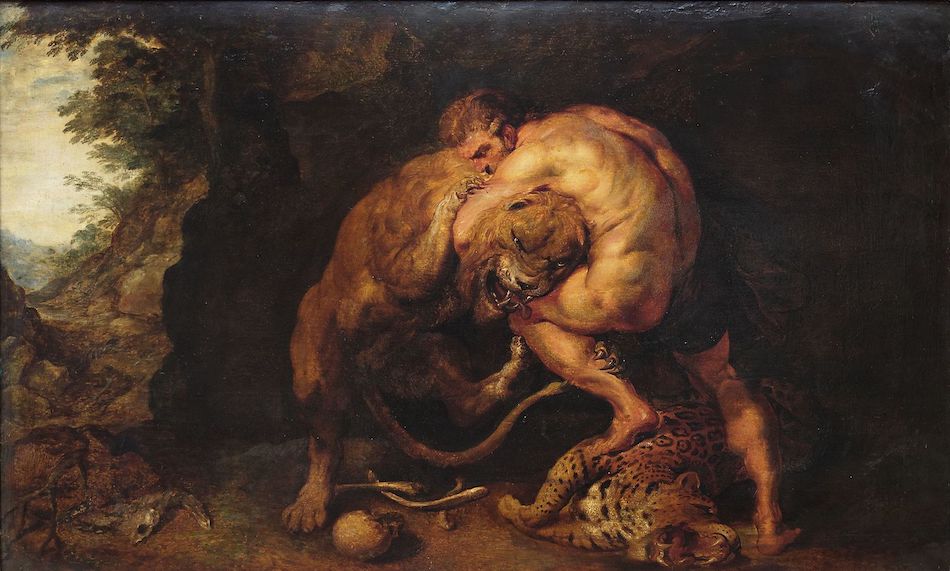
Heracles and the Nemea Lion Pieter Paul Rubens
Just as Tiryns seems to have been subject to the neighboring city of Mycenae during the Bronze Age, Herakles lived in Tiryns while carrying out the commands of his master, the Mycenean king Eurystheus. His first labor was to kill the Nemean lion, a beast which could not be harmed by iron or fire. The lion’s mother was the serpent-woman Echidna, its father was either Typhoeus, the great monster conquered by Zeus, or Orthos, a two-headed dog born of Echidna and Typhoeus, and its brother (in the latter version) was the Theban Sphinx. Since Herakles could not kill the lion with his spear or arrows, he blocked one of the two entrances to its cave, then caught the lion and choked it to death.
When he returned to Mycenae carrying the lion, Eurystheus was so surprised and frightened that he ordered Herakles never again to enter the city. From then on, whenever Herakles returned from one of the labors Eurystheus would hide in a bronze jar in the ground and send his herald Kopreus outside the city to receive Herakles and give him new instructions. Kopreus, a son of Pelops, had been purified by Eurystheus for killing a certain Iphitos, and the price of his purification was to serve Eurystheus as herald. Kopreus is in a sense a reflection of Herakles himself, since Herakles also will kill a man named Iphitos and be forced to seek purification. The name Kopreus means “excrement” and might signify not only Kopreus’ and Herakles’ state of criminal pollution but also the debasement undergone by both, who must serve the coward Eurystheus.
More difficult for Herakles than killing the lion was finding a way to remove its invulnerable hide. He finally discovered that the lion’s hide could be cut only by its own claws, which he used to skin the animal and make a cloak for himself.
The Hydra of Lerna
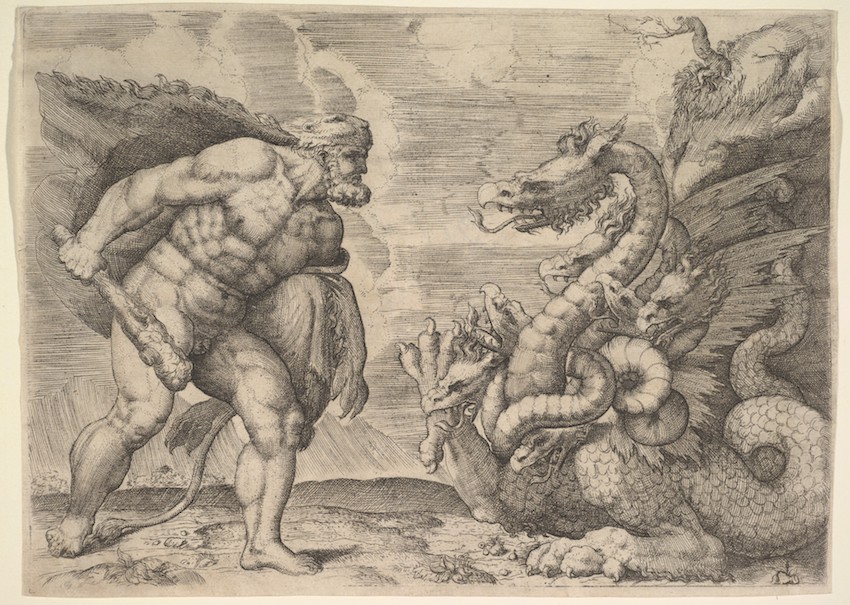
Hercules and the Hydra of Lerna by Marco Angolo del Moro Metropolitan Museum
Herakles’ second labor was to kill the Hydra of Lerna, a water-snake which Hera had raised to fight against him; the Hydra had nine tentacles with a head on the end of each. Herakles had great trouble defeating it, since it wrapped its tentacles around him and immobilized him; furthermore, every time he knocked off one head with his club, two more grew in its place, and, to make matters worse, a huge crab who was the Hydra's best friend kept biting Herakles’ foot. Iolaos, Herakles’ charioteer, saved him by using a torch to cauterize the Hydra’s necks so that no new heads could appear. Herakles was finally able to dispose of all the heads but the middle one, which was immortal; nevertheless it was removable, so Herakles cut it off and buried it under a large rock. He then dipped his arrows in the gall of the Hydra, the second deadliest poison in the mythic world (the most deadly was the blood from the left-hand veins of Medousa).
There are several parallels between Herakles’ slaying the Hydra and Perseus’ killing Medousa: both monsters are female and must be decapitated with a sickle (Herakles uses a “golden sickle”), both heroes need help, both are threatened with immobility, and both make the power of the monster their own (Perseus by using Medousa’s head against his enemies, Herakles by dipping his arrows in the Hydra’s poisonous gall).
Lerna, on the Bay of Nauplion a few miles southwest of Argos, is where the daughters of Danaos buried the heads of their dead husbands after decapitating them on the wedding night.
The Kerynitian Deer
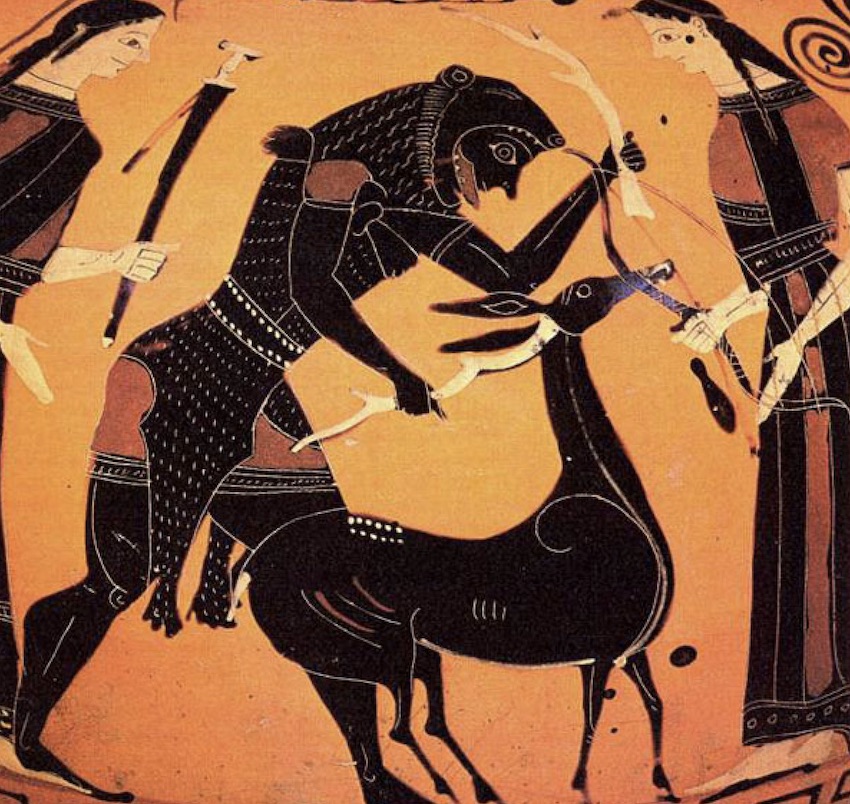
Heracles breaking off the golden antler of the Ceryneian Hind (black-figure amphora, ca. 540–30 BC)
Herakles’ third labor was to bring back the Kerynitian deer, who
lived near the river Kerynitis in the north Peloponnese. Sometimes
described as fire-breathing and monstrous, the deer had golden horns (although
it was female) and was sacred to Artemis, who amused herself by chasing
it. After pursuing the deer for a year, Herakles caught it by the
river Ladon in Arcadia (with nets, arrows, or his bare hands) and brought
it alive to Eurystheus after placating Artemis, who was angry with him
for disturbing her sport. In the poet Pindar’s version Herakles pursued
the deer as far as the land of the Hyperboreans in the imaginary far north.
The only kind of female deer which has antlers is the reindeer. This may be why
Pindar placed this labor in the far north.
The Erymanthian Boar
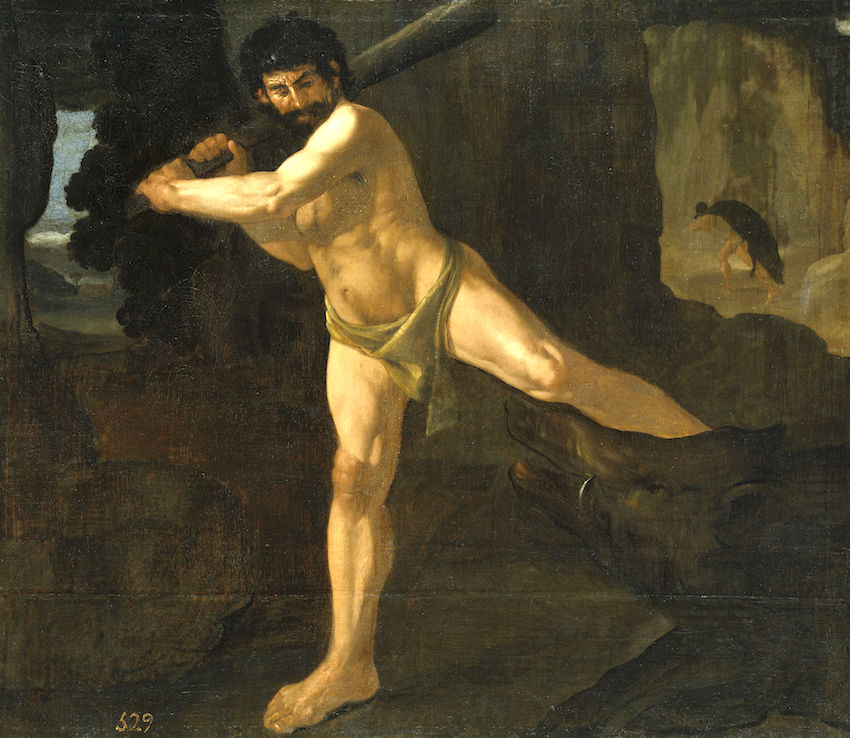
Heracles and the Erymanthian Boar, by Francisco de Zurbarán, 1634 (Museo del Prado)
The fourth labor was to bring back alive the Erymanthian boar, a dangerous animal which lived in Arcadia on the mountain Erymanthos or by the river of the same name. Herakles caught the boar by driving it into deep snow, and took it to Mycenae.
While on his way to hunt the boar, Herakles stopped for dinner at the cave of the centaur Pholos. Pholos ate raw meat but gave roast meat to his guest; however, he refused when Herakles asked him to open a jar of wine which belonged to all the centaurs, since he feared the other centaurs would smell it, even from a distance, and cause trouble. Herakles insisted on opening the wine and the other centaurs, recognizing the smell, came and began fighting with Herakles. Herakles killed some with his newly-poisoned arrows and chased them to Malea (a mountainous cape at the southern tip of the Peloponnese), where they ran for protection to the wise and immortal centaur Cheiron, teacher of many of the mythic heroes.
When one of Herakles’ arrows passed through the centaur Elatos and struck the knee of Cheiron, the poison caused him such anguish that he wanted to give up his immortality and die. Our sources are very confused here, but there may have been a lost version in which Cheiron exchanged his fate with Herakles, thus explaining Herakles’ eventual acquisition of immortality. This story then disappeared in the abundance of other myths concerning Herakles’ becoming a god (he drank Hera's milk, he completed the twelve Labors, he went to the underworld and returned, etc.).
In one version the god Dionysos had left the jar
of wine with the centaurs four generations earlier, telling them not
to open it until Herakles appeared. During the battle the centaurs
were helped by their mother Nephele who, since she was a cloud, was able
to make the ground slippery with rain.
The four-legged half-man half-horse Centaurs are usually said to be the children
of Nephele ("Cloud"). With a few exceptions, they are interested only in
getting drunk and carrying off women. The best-known myth of the centaurs tells
how they went to a wedding in the land of people called the Lapiths in Thessaly,
got drunk at the reception, and tried to run off with the bride and other Lapith
women.
This story is the subject of the relief found most often on Greek
temples, the battle between the centaurs and the Lapiths. The great
exception is the wise, gentle, and immortal centaur Cheiron, at whose academy on
Mount Pelion in Thessaly Jason, Achilleus, and other future heroes studied.
The Stables of Augeias
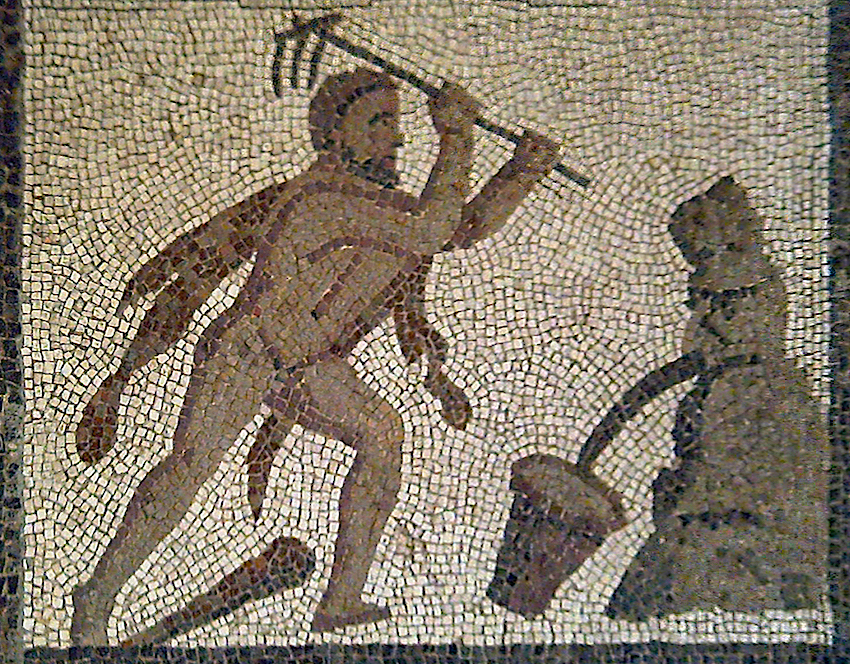
By Luis García, Heracles rerouting the rivers Alpheus and Peneus, to clean out the Augean stables. Roman mosaic, 3rd century AD.
Herakles’ fifth labor was to clean the stables of Augeias, king of Elis (the region of Olympia), in a single day. Herakles made a bargain with Augeias that he would do this in return for a tenth of the cattle, and Augeias’ son Phyleus witnessed the agreement. After cleaning the stables by diverting the river Alpheios through them, Herakles demanded his payment. Augeias not only refused to pay, but denied that he had ever agreed to pay. When the matter was brought to court, Augeias’ son Phyleus testified against his father, but Augeias banished both Herakles and Phyleus before a vote could be taken.
On his way back to Mycenae, Herakles stopped in Olenos at the home of Dexamenos. When he learned that Dexamenos’ daughter was being forced to marry the centaur Eurytion, he killed the centaur.
Augeias’ father is usually Helios, god of the sun,
but some said that his father was the mortal Eleios and his admirers tried
to flatter him by changing his father’s name from Eleios to Helios; others
say that his father is Poseidon.
Augeias is sometimes said to have had infinite cattle (in fact, a school text
which Greek students used to study the problem of fractions of infinite numbers
was a poem about the cattle of Augeias). If he did have infinite cattle, it's
no wonder he refused to pay Herakles a tenth of them (since a tenth of infinity
is infinity).
Herakles' diversion of the river Alpheios has an historical parallel.
During the Middle Ages an earthquake caused the river to change course and flow
over the site of Olympia. When it later returned to its bed, the site was
covered with silt and many ancient statues and artefacts were preserved.
The Stymphalian Birds
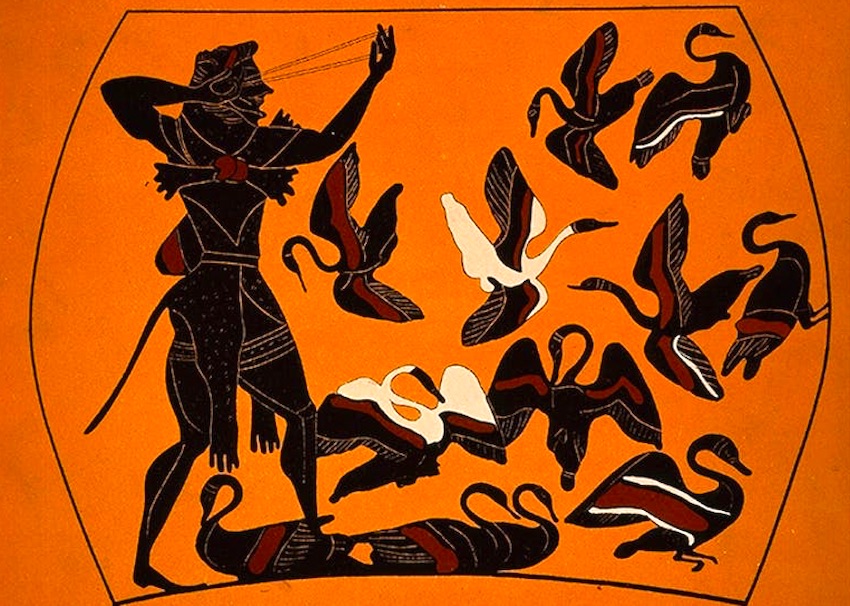
Herakles sixth labor was to exterminate the Stymphalian birds, who lived in great numbers in the woods near Stymphalos in Arcadia. When Herakles was unable to get the birds out of the trees, Athena gave him bronze castanets which Hephaistos had made; striking these together on a mountain nearby, Herakles made the birds fly up in fright and shot them as they flew.
Like the Kerynitian deer, the apparently harmless
birds are sometimes portrayed as dangerous, able to shoot their feathers
like arrows. The traveller Pausanias describes them as man-eating,
possibly descended from large birds of the Arabian desert who were as savage
as lions and killed men with beaks that could stab through bronze or iron.
Pausanias also notes a connection between Stymphalos and Hera (who seems always
to be in the background when Herakles’ life is threatened); Temenos, son of
Pelasgos, raised Hera in Stymphalos, and she returned there after a quarrel with
Zeus.
The Cretan Bull
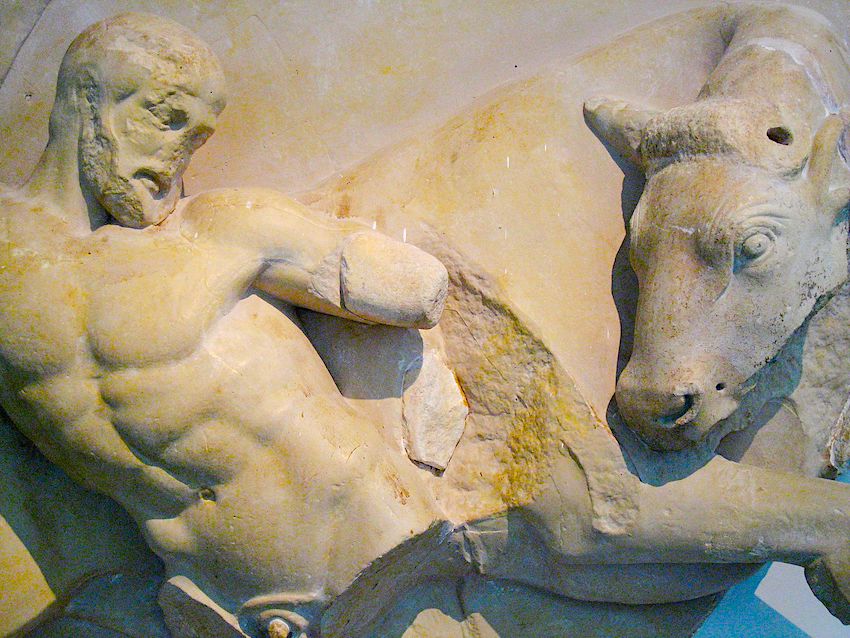
Heracles and the Cretan Bull. Olympia Museum
The seventh labor was to bring back alive the Cretan bull. Poseidon had sent this animal from the sea in answer to the prayer of Minos for a divine sign, so that he could become king of Crete. When Minos neglected to sacrifice the bull to Poseidon as he had promised, Poseidon drove the bull mad and compelled Minos’ wife Pasiphae to fall in love with it; assisted by the clever architect Daidalos, Pasiphae had an affair with the bull and bore a son, the Minotaur. Herakles now caught the bull and took it to Eurystheus, then set it free. It roamed through the Peloponnese and eventually came to Marathon in Attica, where king Theseus killed it.
The Man-Eating Mares of Diomedes
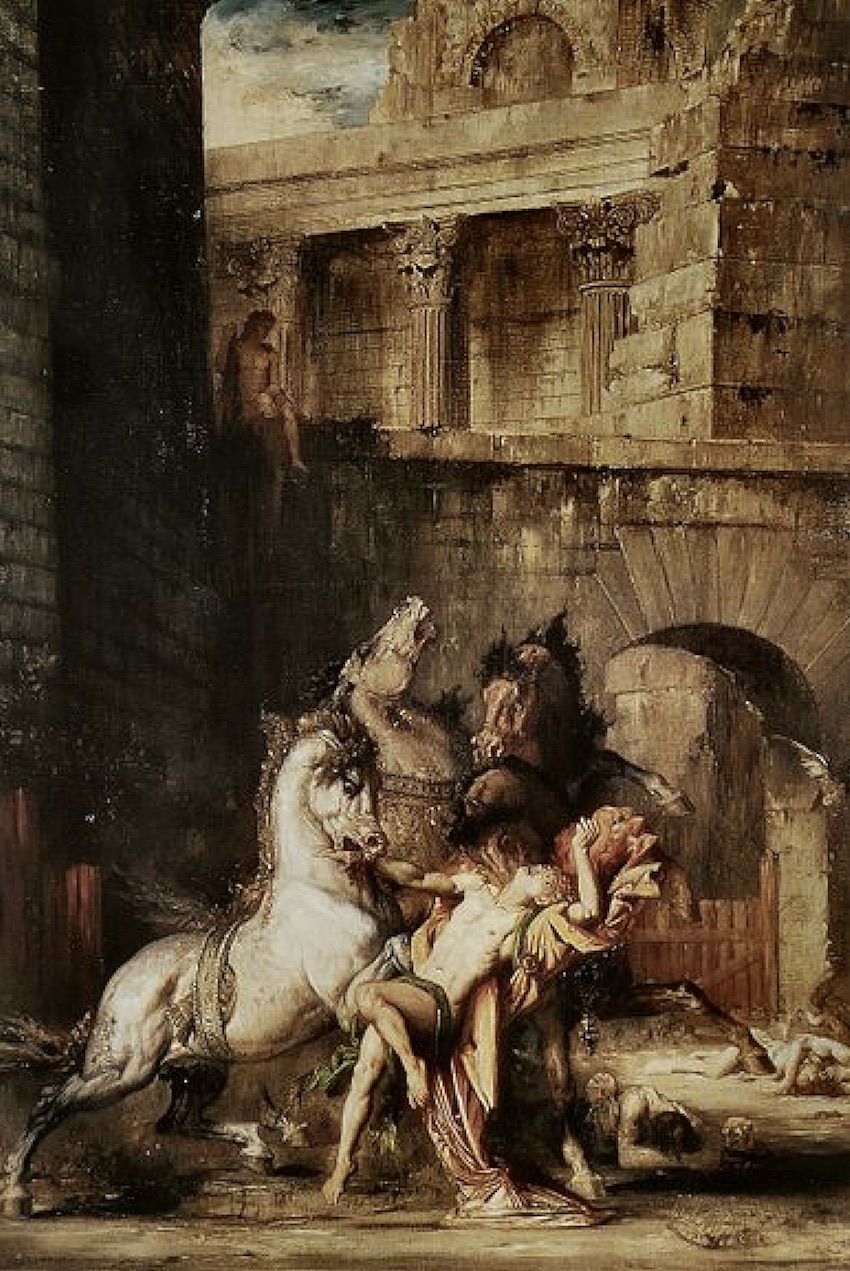
Diomedes Devoured by his Horses - Gustave Moreau (1826–1898)
The eighth labor was to bring back alive the man-eating mares of the Thracian Diomedes, a son of Ares. Herakles sailed with a group of volunteers and captured the mares, then left them with his lover Abderos while he fought against Diomedes and his army. After defeating the Thracians and killing Diomedes (in one version, by feeding him to his own mares), Herakles found that the mares had killed and eaten Abderos. He therefore founded the city Abdera in honor of Abderos and returned with the mares to Eurystheus. He set them free and they eventually were killed by wild animals on Mount Olympos.
The mountain where the mares died is probably not the famous Olympos in Thessaly but one of the other mountains by that name in Elis, Lakonia, or Arcadia.
